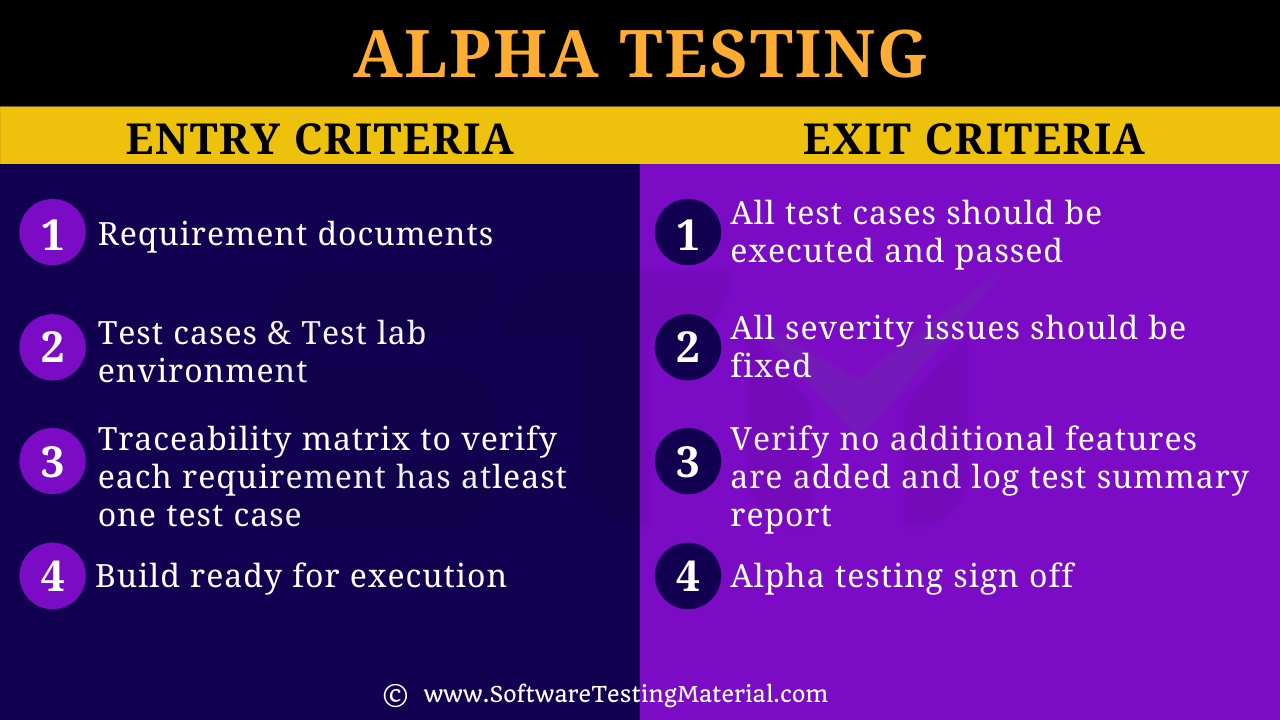Alpha Testing – A Detailed Guide

In this post, we will learn about Alpha Testing (first letter in the Greek alphabet) which helps to simulate real users experience and in the next post, we will learn Beta Testing (second letter in the Greek alphabet) which helps to carry out the testing in a real environment by real users.
What is Alpha Testing?
Alpha testing is a type of acceptance testing that is done by inhouse testers before the application goes live.
The objective of alpha testing is to perform a final round of testing and identify every type of issue which were not discovered in the previous rounds of testing.
It is done by the in-house software engineers as well as the testing team and issues are fixed immediately. The black box & white box testing approach is performed to simulate real users’ experience while performing alpha testing and also to ensure that the application functions as per its intended functionality.
It is the final round of testing done by the group of skilled testers as well as developers at the developer’s site after the acceptance testing and before the Beta Testing.
Who are the Stakeholders
Stakeholders of alpha testing are
- In-house Developers
- QA Team
It is done in two phases.
- The first phase is done by in-house developers to find and fix the bugs quickly.
- The second phase is done by the QA Team by using Blackbox and Whitebox techniques to find bugs to uncover showstopper bugs, usability bugs, requirement gaps, compatibility issues, etc.,
Entry and Exit Criteria:

What are the Entry Criteria for Alpha Testing?
Let’s see the criteria to start alpha tests
- Business Requirement Specification or Software Requirement Document
- Test cases for all the accepted requirements and Test Lab environment
- Requirement traceability matrix to verify each requirement has at least one test case.
- Build ready for execution
What are the Exit Criteria for Alpha Testing?
Let’s see the criteria to pass alpha tests
- All test cases should be executed and passed
- All severity issues should be fixed
- Verify no additional features are added and log test summary report
- Alpha testing sign off
On the basis of Alpha testing sign off, Beta testing can be performed.
Alpha Vs Beta Testing
| Alpha Testing | Beta Testing |
|---|---|
| First stage of user acceptance testing. | Second stage of user acceptance testing. |
| Objective is to make sure that application is working as expected, all functional and performance issues are closed, and application is ready for Beta testing. | To validate that application is satisfying customer needs and requirements completely, customer accept the system by validating all the business scenarios with approval that now system is ready to be launched to its real end users. |
| It is performed by In-house testing team. | It is performed by end users. |
| It is done in the premises where entire team is involved [test and development], it is called lab testing. | It is done at customer premises where no one from development and testing team is present, it is called real time testing. |
| Alpha Testing requires long execution cycle depends on what and how many issues are uncovered. | Beta Testing requires only few weeks of execution. |
| It is done after System testing, when testing team has completed functional, performance and compatibility testing, and system testing is completed, Alpha testing is performed. If any issue is found, on the basis of issue severity issue is fixed and again retesting and regression testing is done. Or Application goes with Open known Issues for Beta testing. | Beta testing is done after Alpha testing is done, With a testing sign off, when all major issues are closed and system is in ready state for use. |
| It requires test environment. | It doesn’t require test environment. |
| Both White box and Black box testing involves in this. | Mainly Black box testing involves in this. |
| Major issues are fixed immediately in Alpha testing. | Issues are collected from the end users and fix them later in Beta testing. |
| Testing, retesting and regression testing is done, means multiple rounds of testing is performed to find issues. | Beta testing is the final testing and it is done on final tested environment and it is done only once. |
| While Alpha testing main testable feature is in-depth functionality, compatibility, performance and usability. Here security and reliability is not a major testing concern. | While Beta testing main high level business scenarios, application reliability, disaster recovery, application security and usability is the main testing concern, all stakeholders should be satisfied with the application functionality and quality. |
| If any high severity issue comes while Alpha testing, cost to fixing is relatively less then Beta testing phase. | If any high severe issue comes in Beta testing then cost of fixing is very high, plus company creditability is also at risk. |
| System Testing is done before Alpha Testing. | Alpha Testing is done before Beta Testing. |
| Beta testing is done after Alpha testing. | Product is released to the public after Beta Testing. |
| Functionality, usability are tested in alpha testing. Reliability and Security testing are not performed in-depth during alpha testing. | Functionality, Usability, Reliability, Robustness, Security testing are performed during beta testing. |
| The build released for Alpha Testing is called Alpha Release. | The build released for Beta Testing is called Beta Release. |
| It evaluates the quality of the product. It answers “Does the product work?” | It evaluates the customer satisfaction. It answers “Do customers like the product?” |
| It ensures whether the application is ready of beta testing or not. | It ensures whether the application is ready for the production launch. |
| Goal is to find bugs. | Goal is to collect feedback from beta testers and evaluate them. |
| Stakeholders for this testing are In-house developers, Quality Assurance Team. | Stakeholders for this testing are Product Management, Quality Management, and User Experience teams. |
Advantages of Alpha Testing
Some of the advantages of alpha testing are as follows.
- It has the ability to provide early error detection and gives confidence to the software team before releasing the application in the market.
- It uncovers showstopper bugs that may arise in real-time.
- Gives a better insight into the reliability of the application at its early stages.
- Shorter delivery time to the market.
- Early feedback helps to improve the quality of the application and gains client satisfaction if minimum defects are found in beta tests.
Disadvantages of Alpha Testing
Some of the disadvantages of alpha testing are as follows.
- The in-depth functionality of the application cannot be tested as the application is still under the development stage.
- It may not be suitable for large projects where rigorous testing is already done. By doing alpha testing again takes longer test execution time.
- It is done by the in-house developers and testers. Due to release deadlines, they may ignore a few defects.
Related posts:
- Beta Testing Guide
- Functional Testing Guide
- Acceptance Testing Guide
- Regression Testing Guide
- Retesting Guide







